You couldn’t miss the explosion of purple and magenta amid the sedate stone and marble interior of Grand Central Terminal’s Vanderbilt Hall. T-Mobile was, at least temporarily, making its mark on the New York icon.
The wireless carrier earlier this month had set up a pop-up event to promote the rebranding of its Metro prepaid arm, but I didn’t really care about that. I was drawn by the promise of a 5G demo.


AR is a technology that could benefit from 5G. Although T-Mobile’s demonstration wasn’t running on 5G at all.
T-Mobile
And in one tiny part of the hall, jammed next to a giant replica of an Amazon Echo smart speaker, was a random collection of devices and experiences primed for 5G. There was a drone that could tap into the network for real-time controls and data exchange. An exercise bike and headset promised a cowboy-themed virtual reality experience. A collection of wine bottles featured photos of T-Mobile executives like CEO John Legere as an example of augmented reality — point your smartphone at a bottle and Legere comes to life on the screen with a quip about how T-Mobile’s innovation is “truly intoxicating.”
Eager to get started, I asked when I could tap into that 5G network.
“Oh, there’s no 5G set up yet,” said a T-Mobile spokeswoman, explaining that these were “simulations.”
It was hard to hide my disappointment. But I shouldn’t have been surprised — that’s been the story of 5G hype over the last several years. There have been tons of promises and fancy demonstrations for what 5G might look like, but few concrete, real-world examples.
That’s changing, with Verizon launching its 5G-based home broadband service (sort of) and AT&T poised to launch a mobile 5G service this year. Around the world, carriers in Korea, Japan and China are set to make the big 5G leap over the next year.
The next-generation of cellular technology, 5G promises to change your life with a massive boost in speed and responsiveness. It’ll power applications like self-driving cars, telemedicine and a new universe of connected devices. You can expect to see 5G smartphones coming out in the first half of next year.
The bad news: Don’t expect your life to change quite yet. As with any new technology, 5G will experience some growing pains, and for many people, those promised speeds may not show up consistently — or at all. I talked to a number of experts and telecom industry executives to get a bead on what 5G will really look like in the early days.
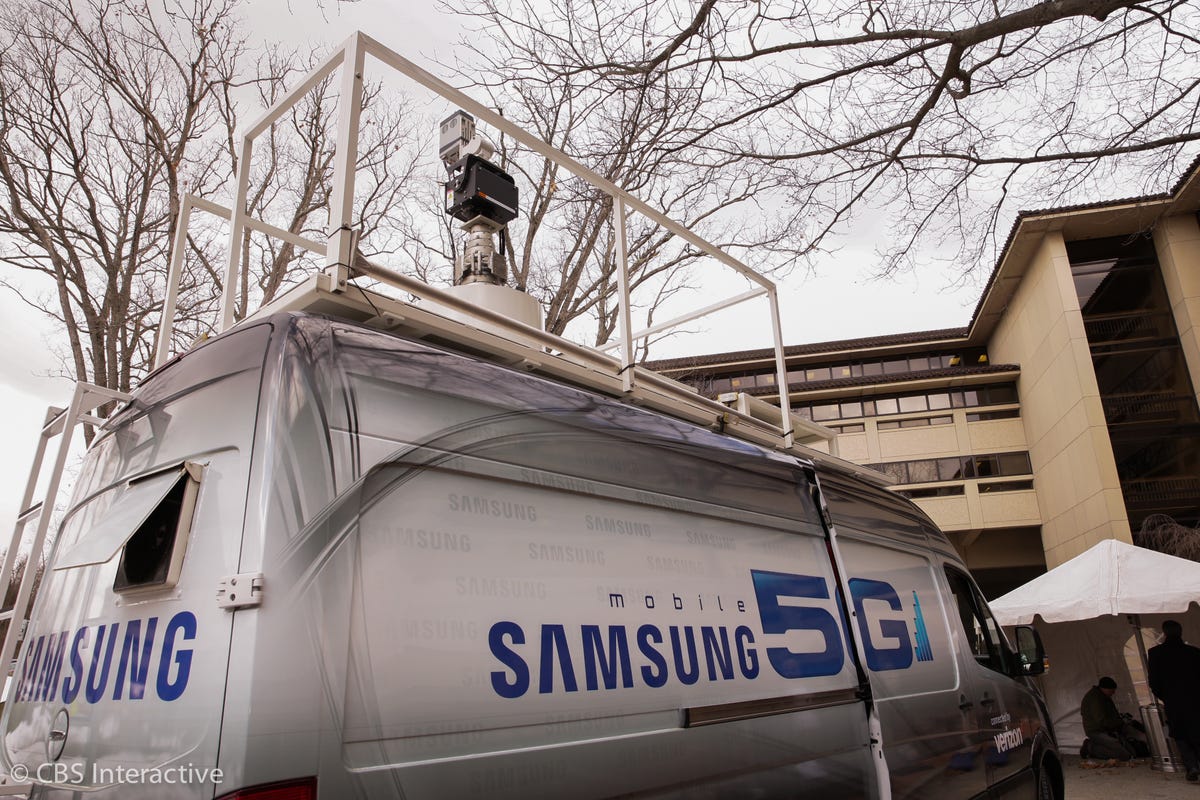

An early 5G test van parked at the Verizon campus in Basking Ridge, New Jersey.
Sarah Tew/CNET
Off to the 5G races
The US carriers began jockeying for the 5G pole position early — Verizon talked about field trials back in 2015. With advanced networks being the next big thing, each carrier is eager to bolster its reputation for service quality, which they hope will translate into consumers heading their way.
Sprint has promised to build the first nationwide 5G network by early 2019. It’ll take a big step in that direction this year when it rolls out 5G capabilities to nine cities, including New York, Chicago and Los Angeles, though Sprint customers won’t be able to access 5G until the service launches next year.
T-Mobile said it would deploy 5G in 30 cities this year — including New York and Los Angeles — but likewise wouldn’t launch the service until 2019 because 5G phones aren’t ready.
The two companies have agreed to merge, and T-Mobile says Sprint’s radio airwave assets could supercharge its ability to build out a 5G network faster than it could alone. T-Mobile Chief Operating Officer Mike Sievert said in an interview in August that the company aims to make speeds of 100 megabits a second or faster available to 90 percent of the country, with average speeds of 450 Mbps by 2024.
AT&T has said it will have mobile 5G available in a dozen markets, including Atlanta and Dallas, later this year. But it’s unclear just how broadly available the coverage will be.
Earlier this month, Verizon launched its Home 5G broadband service in select neighborhoods in Los Angeles, Sacramento, Dallas and Indianapolis. But the company is using a proprietary variant of 5G — and not the industry standard — which led some to argue that it fudged its way to the starting line. Verizon said it wouldn’t expand its limited initial commercial rollout this year, and will begin delivering the service to more homes once it switches to the industry standard next year.
Verizon has now launched its mobile 5G network and has ambitious plans for its network speeds, saying some areas could get 5 gigabits per second, or five times the fastest home broadband connection, according to Brian Higgins, vice president of device and product marketing.
After mocking Verizon about its home broadband plans, T-Mobile is now saying it wants to get into the 5G broadband business too.
Then there’s a cable company that’s seriously talking about 6G already.
All of these plans are enough to make your head spin.
“It’s a little confusing, isn’t it? It’s confusing to me, and I do this for a living,” T-Mobile Chief Technology Officer Neville Ray quipped at a press conference back in March.
‘Pucks’ versus phones
At the 2017 Mobile World Congress trade show, Roger Gurnani, then the chief information and technology architect for Verizon, walked on stage during a Samsung tablet event to talk about the two companies’ work on developing 5G.
Gurnani spoke of the field trials that were under way, and at the end he teased that we might see a Samsung 5G phone in a year. It wasn’t clear whether he was joking — the Samsung executive next to him looked surprised by the suggestion.
Fast-forward to this year’s show in March, and now deep into 2018, and the only thing certain is that no 5G phone exists.
Because those phones aren’t ready yet, AT&T plans to deploy “pucks,” or mobile hotspots, that capture 5G signals and broadcast Wi-Fi, giving your devices a portable internet connection.
Pucks and laptop cards were prevalent when 4G LTE first rolled around, because it was the easiest and cheapest way to release a device running on a next-generation wireless device.
Chances are, you’re probably never going to use one. These were niche devices even back in the early LTE days, although some people use them now for work to get a temporary Wi-Fi network running.
You’re likely more interested in the first 5G phones. Qualcomm President Cristiano Amon said during a July earnings conference call that every handset maker using its flagship Qualcomm Snapdragon 800 platform had a 5G phone slated for 2019 — a year earlier than previously expected.
But be mindful that the early batch may suffer from some of the issues that plagued early 4G phones. Devices such as the HTC Thunderbolt were bulky, had poor battery life and tended to overheat.
Sprint and LG have vowed to create the first 5G-powered smartphone in the US, and John Tudhope, director of product marketing for Sprint, said the companies have taken into account the issues from 4G.
While T-Mobile’s Ray said he expects a premium flagship will get 5G, AT&T Chief Technology Officer Andre Fuetsch said there may be phones specifically built to house 5G technology, similar to the Thunderbolt.
Related 5G stories
- Here are the first cities to get AT&T’s mobile 5G network
- Sprint: We’re in a unique position to deliver broader 5G
- T-Mobile will deploy blazing 5G this year, but you can’t use it
- FCC chairman defends net neutrality’s end as he opens 5G door
“The first generation will come with its challenges,” Fuetsch said in an interview in March.
Verizon downplayed the concerns. “We learned a lot by being the 4G LTE leader,” said Brian Higgins, head of devices for Verizon, in an interview in March. “One of those is how to help our ecosystem partners improve the infrastructure, device, battery life and apps required to take advantage of new technology.”
Also, don’t expect a 5G iPhone anytime soon.
Spotty coverage at first
Another problem with 4G LTE in those early days was coverage gaps. One minute, you were enjoying high-speed online access and streaming video, and then everything came grinding to a halt as you were kicked back down to 3G. Even if you got back into a 4G area, the phone often wouldn’t recognize it.
“Consumers should absolutely expect those early 5G networks will suffer from some of the same ills,” said Dan Hays, a consultant at PricewaterhouseCooper.
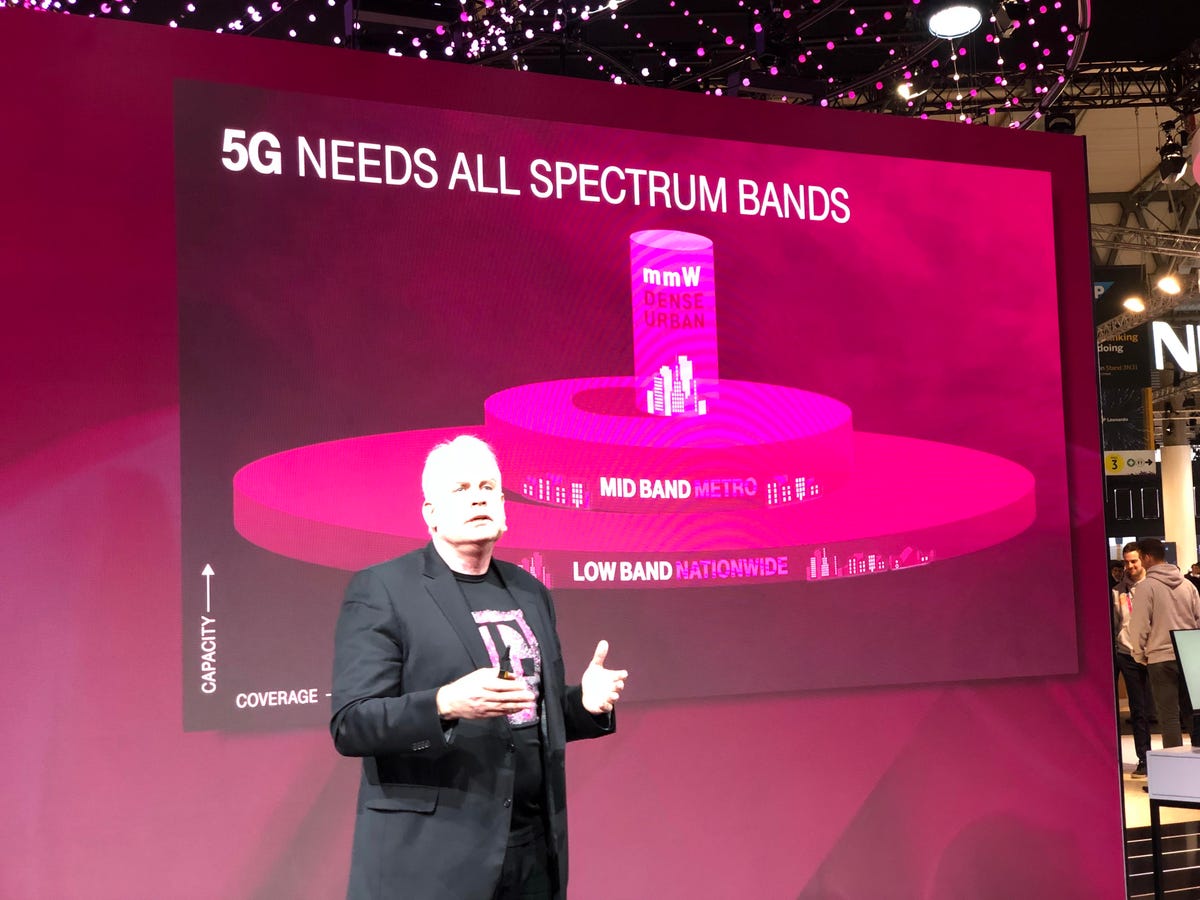

T-Mobile Chief Technology Officer Neville Ray at MWC 2018 as he explains how the company’s use of different bands of spectrum resembles different layers on a cake.
Roger Cheng/CNET
Given how fast 5G is supposed to be — anywhere from 10 to 100 times faster — there could be a more dramatic dropoff this time around. That’s especially the case with super-high-frequency radio waves, which deliver the fastest wireless speeds, because they often have short range and can easily be disrupted.
“Imagine if you’re going on a highway at 60 miles per hour, and then you get stuck on a street going 10 mph,” said Jefferson Wang, a managing director at Accenture Strategy. “It’s a jolt.”
The high-frequency airwaves, often referred to as millimeter-wave spectrum, require a lot more “small cells,” or compact boxes that broadcast and carry cellular signals. The Federal Communication Commission has opened the door to faster deployment of these boxes, but it will likely butt up against local municipalities and residents who don’t necessarily want them so close. That’s a potential point of tension amid all the enthusiasm for the technology.
If the carriers don’t get enough small cells deployed, you’ll likely run into small areas of intense speed and capacity, with a drop-off elsewhere as you go beyond the range of millimeter spectrum.
The carriers intend to round out the coverage with lower-frequency airwaves for 5G, offering broader coverage and less chance of a dramatic fall to 4G.
“The 5G experience from Sprint will be more uniform,” Sprint Chief Technology Officer John Saw said in March.
But for all of the carriers, there’ll be plenty of areas with no 5G coverage. That’s particularly true for the deployments we’ll see this year and in 2019.
The good news: Carriers are also upgrading their 4G networks with higher speeds so the transition won’t be so bad. They’re all employing a technology called Gigabit LTE, which boosts current speeds considerably. Phones like the Samsung Galaxy S9 and the iPhone XS are already able to access it.
Price hikes?
Another concern is whether prices will change with the introduction of 5G. Former Sprint CEO Claure said in a keynote address at MWC in March that he expected 5G to be marketed as a premium service with a premium price tag.
Sprint wasn’t available to comment on whether this is still the thinking under new CEO Michel Combes, although plans may change if T-Mobile completes its deal with Sprint.
Is it that crazy in this competitive environment? Wang notes that the model already exists for home broadband.
“You are already tolerating a payment for higher speeds,” he said.
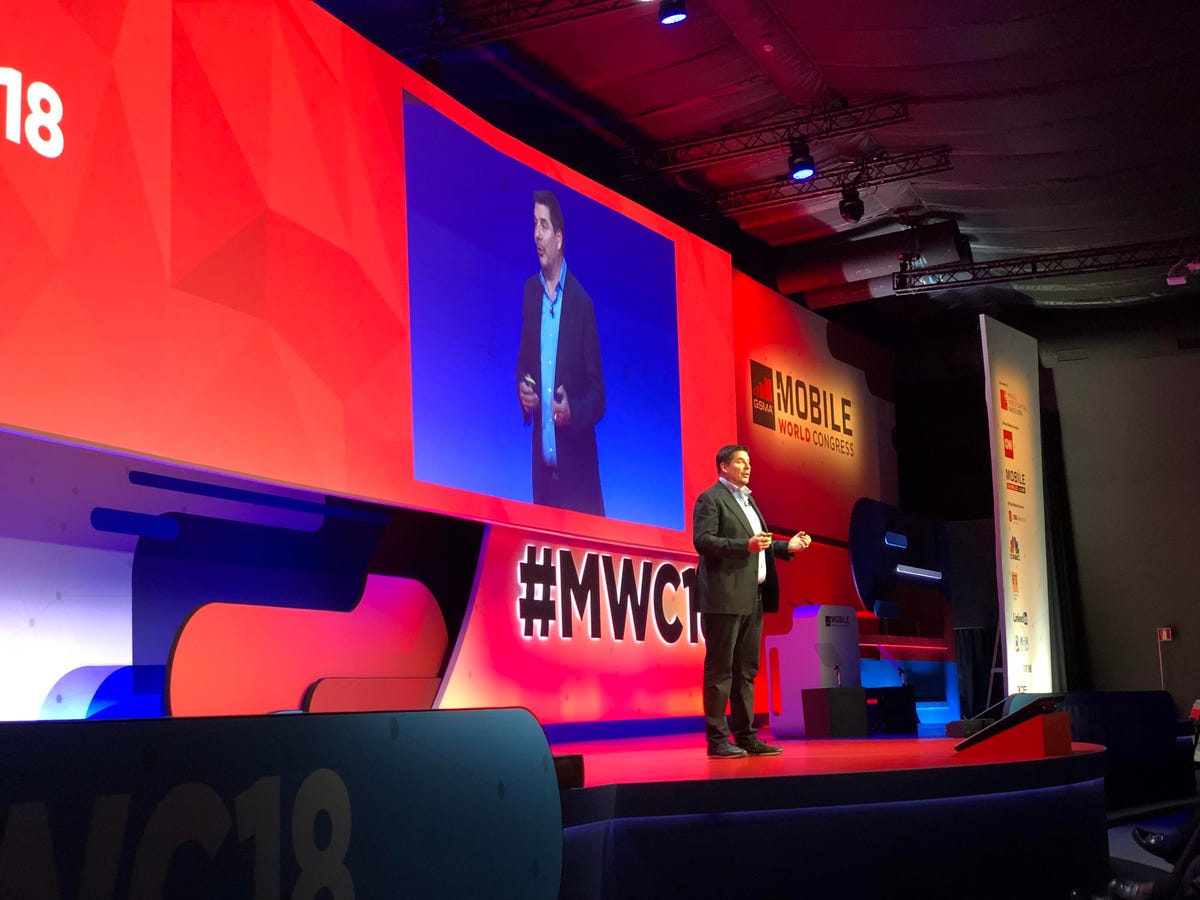

Sprint CEO Marcelo Claure speaking at MWC 2018. He believes 5G gives him a chance to raise prices.
Roger Cheng/CNET
Others are a bit skeptical. Hays doesn’t believe consumers will pay a premium because there aren’t any obvious benefits yet. After all, you can stream Stranger Things on your phone just fine on 4G.
“To think you can just put 5G out there and just say now it’s some form of premium service, I think that’s probably going to be a little mythical,” T-Mobile’s Ray said.
At this year’s MWC, I asked Verizon CEO Hans Vestberg about the claim made by Gurnani, who’s no longer with the company. Vestberg said he expects to see 5G phones by MWC 2019.
“But,” he added after a brief pause, “it’s a qualified guess.”
Originally published March 2 at 5:00 a.m. PT. Updated Oct. 17 at 6:00 a.m. PT: Added new details including a description of T-Mobile’s Metro event, plus updated information, background and more.
Updated Oct. 18 at 5 a.m. PT: Adds a new line from Qualcomm.
MWC 2018: All the phones and gadgets announced so far
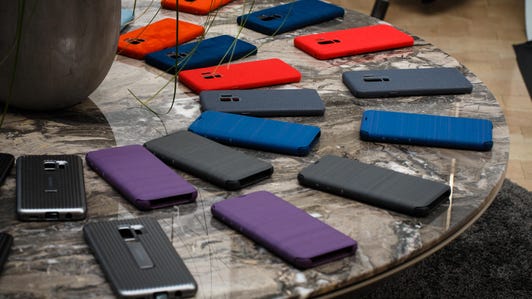

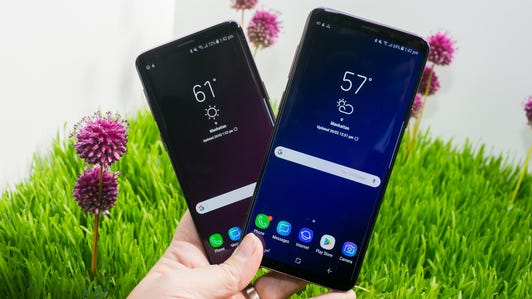



+17 more
5G: Your Next Big Upgrade: CNET’s series on the next generation of cellular technology.
The 5G revolution: Everything you need to know about the wireless technology.



